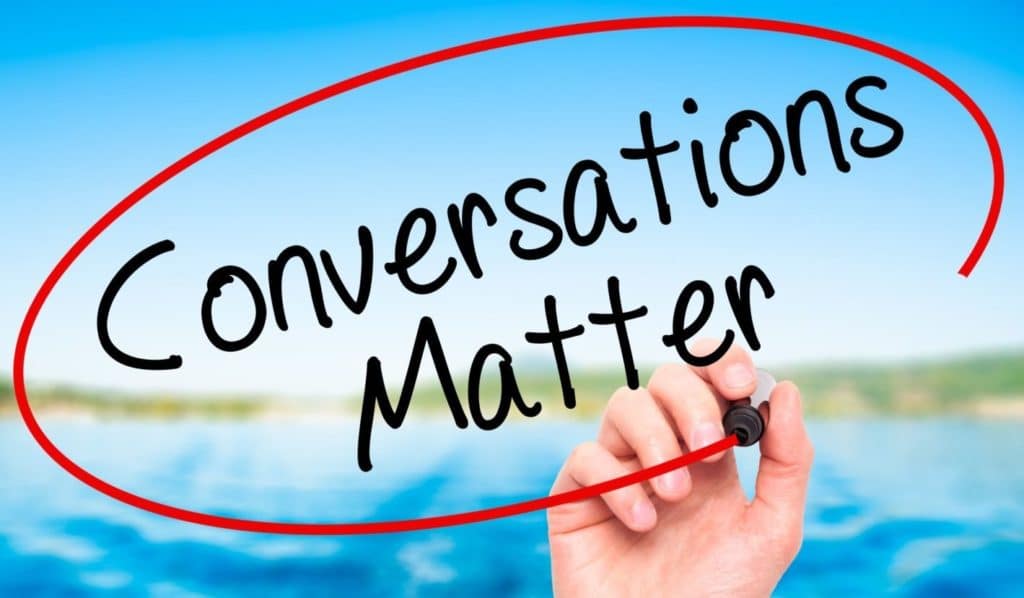Teacher Stephanie Hruzek tells the story of the 10 year old boy who gave her a note he claimed he had found on the floor. It was an obscenity-laced tirade. When Stephanie asked him who would write such an angry note, he said he didn’t know. Later that night the staff watched the footage from video cameras, and saw that the boy who brought the note was the one who’d actually written it. When they confronted him with the evidence, he denied it at first, and perhaps a natural impulse would have been to punish him for the hate-filled document. But instead of acting quickly they sat with him for a while and talked. Eventually he began to cry and said “I wrote that note to a man who hurt me”. So the obscenities were his way of showing that there was something important going on, a cry for help – but the actual issue was only revealed after a patient and open conversation, which then allowed a different and much more important matter to emerge. The slow conversation revealed that what seemed to be one problem was in fact a very different one.
I can think of a colleague who, many years ago, had shouted and raged at another colleague over a completely trivial matter. This second colleague had come to see me, and after hearing the story I went to see the first one. It turned out he had been hospitalised the previous weekend with vertigo, and was adjusting to medication. Not an excuse to shout at an innocent, of course, but important context; and one that made the difference between being sent home and being asked if he needed to take some time away from school. Again, the real issue was not the presenting issue.

Stories like these show how there is much that can be revealed through patient, caring conversations, which are the bread-and-butter of meaningful relationships. They take time and attention, and most importantly the will to listen and ask thoughtful questions. They are the best investments we can make in people we care about.
This is closely related to the vision of childhood and education. If the fundamental goal is to seek obedient little workers, compliant to our needs, then command and control may be enough. But if we are seeking to develop critical, ethical adults, then we need to go beyond demanding compliance to allow our children to make up their own minds – with our support and guidance, of course. And then it follows, I think, that a crucial part of this must be through conversations – because no matter what lessons, books, or even experiences we give to our children, the meaning of these things are most profoundly understood and learnt through conversations.
It seems strange, therefore, that we tend to take the art of conversation for granted; to simply plough through potentially transformative discussions as and when they arise without really giving them much care. Most conversations are intuitive, unstructured and unintentional, and it’s hard to imagine any other important area of our lives that we give so little attention to! Planning even mundane events like, say, shopping, usually involves thinking ahead a few weeks, making a list, considering alternatives, planning a time, having a clear sense of purpose and so on. But we often just launch into important, even crucial conversations with no equivalent preparations. The more I think about it, the more remarkable I think this is.

One way of approaching things is to become familiar with various conversation strategies and maps. Maps can be quite complex multi-step routes to maximise the effectiveness of reflective, problem-solving or evaluative conversations (for example) because each one requires different approaches. Strategies, by contrast, are specific techniques that can be applied more easily and opportunistically. A simple example is motivational interviewing, developed by Mike Pantalon at Yale University. It’s a two step process. Let’s say I am trying to persuade tardy students to meet deadlines. I ask “On a scale of 1 to 10, how likely are you to meet the deadline?” The reply might be, “Well, I have a lot of other things on, so I guess a 4.” Now a natural instinct might be to respond “Not good enough! Make it a 9!” but the protocol suggests that a better approach might be to follow up instead with the rather counter-intuitive “So, you are a 4; now tell me why you didn’t choose a lower number?“
The point here is that the students have to explain – maybe for the first time – why they are able to exceed the minimum; why they are not at the bottom. Crucially, they are forced to examine their own motivations and find their own strengths. They are not being confronted with the unpleasant sight of their own weaknesses, and the long road ahead to get from a 4 to a 10, but are able to look at where they already actually are, and why they are there. That is, after all, where their journeys have to start from.This is a simple strategy. I imagine that the success of the conversation will be found not in the moment, but over time, as it should support better thinking, not just better single actions. So this is a very simple example of perhaps an important truth; that we need to be letting our children find their own answers, and to grow out of our control (and into their own). Dan Pink (author of the brilliant Drive) describes it well: “As parents, as teachers, as entire organizations, our instinct is toward greater control. We think control is going to make something better. But people have only two reactions to control: They comply, or they defy. We don’t want defiant kids, but we also don’t want compliant kids. We want kids who are engaged. If you truly want to engage kids, you have to pull back on control and create the conditions in which they can tap their own inner motivations”
The upshot here is that many conversations are successes if, and only if, they promote, provoke or somehow encourage further thought. It’s worth bearing in mind that getting the conversations right may be the most important thing we can do for our children.


